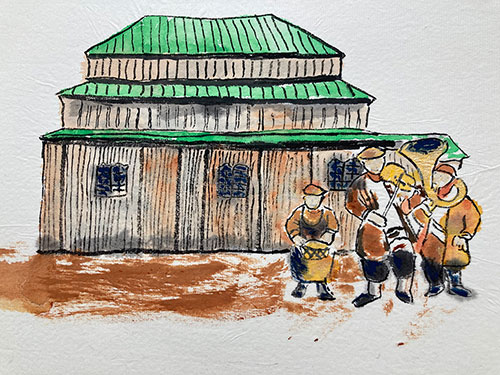Lost Treasures: The Wooden Synagogues of Eastern Europe The Artwork of Bill Farran
Nowe Miasto, Poland - Sumi-e Style Brush Painting
Nowe Miasto, Poland - Sumi-e Style Brush Painting
Nowe Miasto means new town. There are at least 7 Nowe Miasto’s in Poland. This Nowe Miasto is located at 52°39' N, 20°38' E. The Jews did not face any obstacles in coming to settle in Nowe Miasto. In the second half of the 18th century, about 30 Jewish families lived in the town, who were occupied mainly in trades and commerce. A small group of Jewish merchants became wealthy from wholesale grain commerce and as leaseholders on plots of forest to be felled. In the late 19th century, Jews owned a water mill, and a sawmill. The owner of the beer factory in Nowe Miasto was also a Jew. In these relatively large factories Jews were not employed, apart from family members of the owners and a few clerks.
In the mid-18th century, the Jews had an independent kehilla [Jewish community council]. In this period, the old wooden synagogue was built, with artistic interior decoration, such as on the Torah ark and the bimah, carved from wood.
In the 1930s, the Jews of Nowe Miasto suffered greatly from the increasing anti-Semitism [then prevalent across Poland]. Jewish peddlers were not permitted at all to enter the villages. On market days the Endeks [members of the anti-Semitic Polish Narodowa Demokracja party”] placed boycott guards in front of Jewish shops and market stalls.
The Nazis occupied Nowe Miasto in late 1939. The Germans ordered the dismantling of the old synagogue, as they hesitated to burn it for fear of the fire spreading. In October of 1942 the Jewish town of Nowe Miasto ceased to exist.
Purchase a print
Sumi-e Style Brush Prints are 8x10 inches, in an 11x14 matte.
